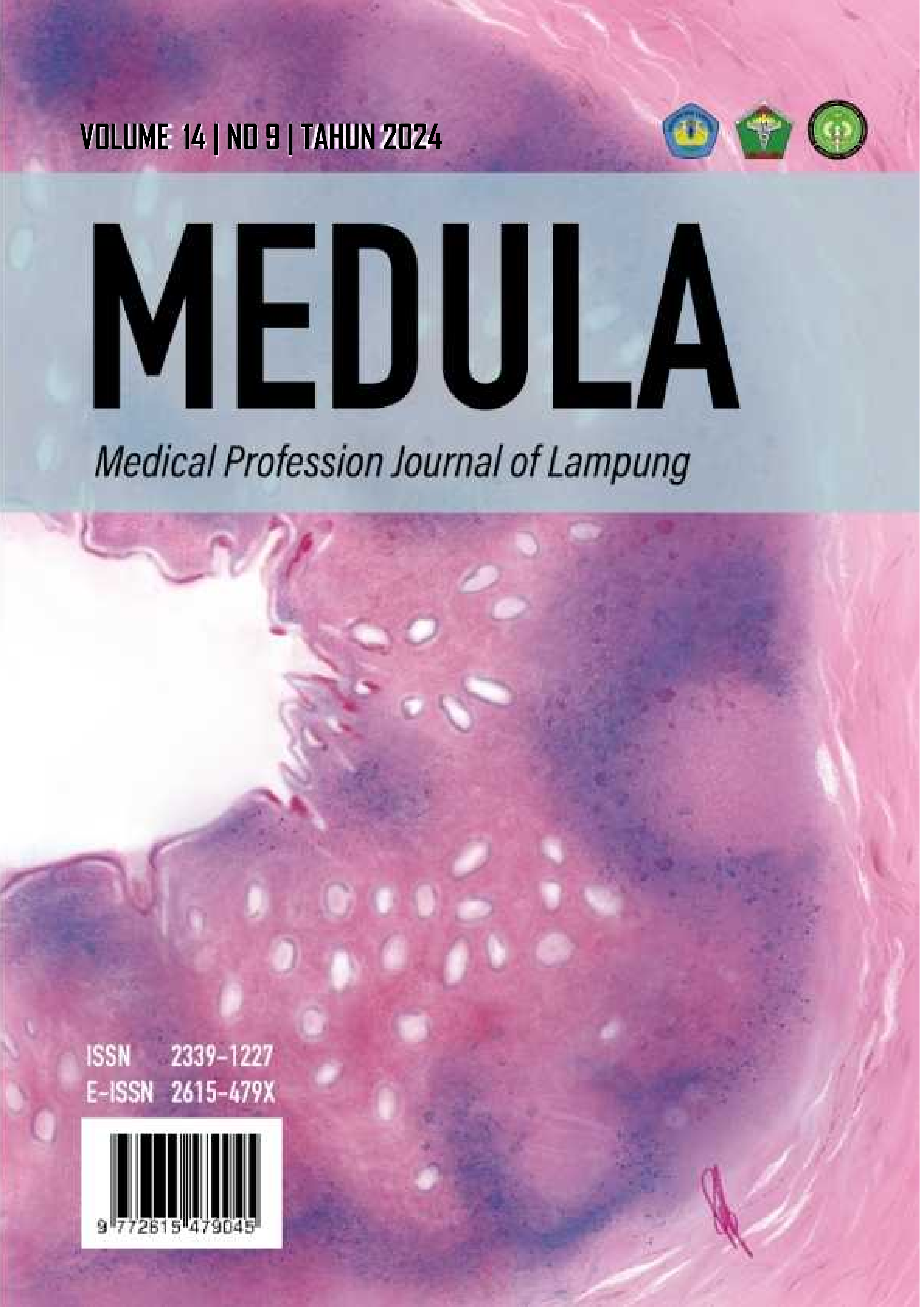Literature Review: Acute Kidney Injury by Gentamicin-Induced Nephrotoxicity
DOI:
https://doi.org/10.53089/medula.v14i9.1312Keywords:
Acute kidney injury, gentamicin, nefrotoxicityAbstract
Acute kidney failure or Acute Kidney Injury (AKI) is a sudden decline in kidney function that is often caused by various factors such as sepsis, ischemia, and nephrotoxicity. One of the significant causes of nephrotoxicity is gentamicin, an aminoglycoside antibiotic commonly used to treat Gram-negative bacterial infections. Although effective, gentamicin has nephrotoxic side effects, especially at high doses or long-term use, which can cause damage to the renal tubular epithelium and trigger AKI. This literature review aims to describe and study more deeply the relationship between gentamicin consumption and the incidence of acute kidney failure. Gentamicin works by inhibiting bacterial protein synthesis on the 30S ribosome. Still, its mechanism of action also has the potential to cause nephrotoxicity through drug accumulation in kidney cells, impaired mitochondrial function, increased production of reactive oxygen species (ROS), and mesangial contractions that reduce the glomerular filtration rate. Signs of gentamicin nephrotoxicity include increased serum creatinine levels, blood urea nitrogen, albuminuria, and decreased glomerular filtration rate, accompanied by structural damage such as tubular necrosis and edema in the proximal tubular epithelium. Previous studies have shown that high doses of gentamicin can increase the number of necrotic cells in the kidney and cause renal fibrosis in test animals. In humans, the incidence of gentamicin-induced nephrotoxicity has been reported to reach 10-25% of therapeutic use, with an estimated incidence of AKI of around 15% of total AKI cases. The importance of proper monitoring and management for patients using gentamicin to reduce the risk of nephrotoxicity. Prevention strategies include monitoring kidney function, dose adjustment, adequate hydration, and considering various alternative antibiotic therapies for patients at high risk of nephrotoxicity.
References
Makris K, Spanou L. Acute Kidney Injury: Definition, Pathophysiology and Clinical Phenotypes. Clin Biochem Rev. 2016 May;37(2):85–98. 2. Gary NE, Buzzeo L, Salaki J, Eisinger RP. Gentamicin-associated acute renal failure. Arch Intern Med. 2020 Oct;136(10):1101–4.
Gamaan M, Zaky H, Ahmed H. Gentamicin-induced nephrotoxicity: A mechanistic approach. Azhar International Journal of Pharmaceutical and Medical Sciences. 2023 Mar 16;0(0):0–0.
Kementerian Kesehatan Republik Indonesia. Kementerian Kesehatan Republik Indonesia. 2022. Kasus Baru gagal ginjal Akut Mulai Menurun.
Almazmomi MA, Esmat A, Naeem A. Acute Kidney Injury: Definition, Management, and Promising Therapeutic Target. Cureus. 2023 Dec 28;
Chaves BJ, Tadi P. Gentamicin [Internet]. StatPearls Publishing; 2023 [cited 2024 Nov 10]. Available from: https://www.ncbi.nlm.nih.gov/books/NBK557550/#_article-22211_s2_
Randjelovic P, Veljkovic S, Stojiljkovic N, Sokolovic D, Ilic I. Gentamicin nephrotoxicity in animals: Current knowledge and future perspectives. EXCLI J. 2017;16:388–99.
Balakumar P, Rohilla A, Thangathirupathi A. Gentamicin-induced nephrotoxicity: Do we have a promising therapeutic approach to blunt it? Pharmacol Res. 2020 Sep;62(3):179–86.
Latif AC. Gambaran Histopatologi Ginjal Yang Diinduksi Gentamisin dan Pemberian Tepung Buah Jambu Biji Merah (Psidium Guajava L.) Pada Tikus Putih (Rattus Norvegicus). Prosiding Seminar Nasional Cendekiawan ke 5. 2019;1–7.
Lusiana E, Saleh I, Sinaga E, Hafy Z. Efek Nefrotoksik Gentamisin Terhadap Tikus Wistar. Medica Hospitalia : Journal of Clinical Medicine. 2023 Jul 31;10(2):129–37.
Quiros Y, Vicente-Vicente L, Morales AI, Lopez-Novoa JM, Lopez-Hernandez FJ. An Integrative Overview on the Mechanisms Underlying the Renal Tubular Cytotoxicity of Gentamicin. Toxicological Sciences. 2011 Feb 1;119(2):245–56.
Lintong PM, Kairupan CF, Sondakh PLN. Gambaran Mikroskopik Ginjal Tikus Wistar (Rattus norvegicus) Setelah Diinduksi Dengan Gentamisin. Jurnal Biomedik. 2012;4(3):185–92.
Rahmawati TG. Pengaruh Msc-Cm Dosis Tinggi Terhadap Kadar Ureum Pada Gagal Ginjal Akut (Studi Eksperimental In Vivo Umbilical Cord Mesencymal Stem Cell Conditioned Medium Pada Kultur Hipoksia Terhadap Tikus Jantan Galur Wistar yang Diinduksi Gentamicin) [Skripsi]. [Semarang]: Universitas Islam Sultan Agung; 2021.
Moore RD. Risk Factors for Nephrotoxicity in Patients Treated with Aminoglycosides. Ann Intern Med. 2015 Mar 1;100(3):352.
Raveh D. Risk factors for nephrotoxicity in elderly patients receiving once-daily aminoglycosides. QJM. 2012 May 1;95(5):291–7.
Selby NM, Shaw S, Woodier N, Fluck RJ, Kolhe N V. Gentamicin-associated acute kidney injury. QJM. 2019 Dec 1;102(12):873–80.
Purnasari C, Manggau MA, Kasim H. Studi Pengaruh Dosis dan Lama Penggunaan Terapi Aminoglikosida Terhadap Fungsi Ginjal. Majalah Farmasi dan Farmakologi. 2018;22(3):76–80.
Kusuma PW, Sudira IW, Berata IK, Merdana IM. Perubahan Histopatologi Ginjal Tikus Putih yang Diberikan Ekstrak Etanol Sarang Semut dan Gentamisin Dosis Toksik. Indonesia Medicus Veterinus. 2020 May 31;9(3):466–74.
Ross JDC, Brittain C, Cole M, Dewsnap C, Harding J, Hepburn T, et al. Gentamicin compared with ceftriaxone for the treatment of gonorrhoea (G-ToG): a randomised non-inferiority trial. The Lancet. 2019 Jun;393(10190):2511–20.
Downloads
Published
How to Cite
Issue
Section
License
Copyright (c) 2025 Medical Profession Journal of Lampung

This work is licensed under a Creative Commons Attribution-ShareAlike 4.0 International License.














